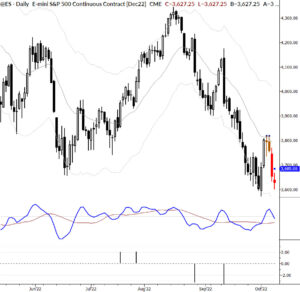This could, perhaps, be the shortest blog post ever. I could simply answer the question with: follow your rules. Get out. But let’s dig a little deeper.
Before we really begin, it’s important to remind ourselves that there are many ways to trade and invest successfully. Yes, there are many more ways to do it unsuccessfully, but there is no one true path to trading success. Having said that, one of the most important things with any trading methodology is knowing where you are getting out when you’re wrong. This might seem to be a problem with fundamental or value-based approaches that do not place stops on positions. In fact, if you believe in your analysis and the price continues to go down, the logical course of action is to buy more.
 Technical traders, who typically place concrete stops on positions, might look at a fundamental approach and say that investors working like this do not understand risk. I think that is not quite true, and it is really just a different perspective on risk. Most fundamental investors do know that their risk is 100% of the amount invested in the position, which is why these investors typically focus on the percentage of capital allocated to each position. Limit that to a reasonable size, and you have, in fact, limited your loss to that amount invested. This may also explain why many investors are so adverse to shorting. The specter of a “theoretically unlimited loss” always seemed silly to me, but if you aren’t used to putting price-based stops on positions it could be a reality. Invest 5% of your capital and you can afford to lose 100% of that 5%, but you cannot afford to lose 500%!
Technical traders, who typically place concrete stops on positions, might look at a fundamental approach and say that investors working like this do not understand risk. I think that is not quite true, and it is really just a different perspective on risk. Most fundamental investors do know that their risk is 100% of the amount invested in the position, which is why these investors typically focus on the percentage of capital allocated to each position. Limit that to a reasonable size, and you have, in fact, limited your loss to that amount invested. This may also explain why many investors are so adverse to shorting. The specter of a “theoretically unlimited loss” always seemed silly to me, but if you aren’t used to putting price-based stops on positions it could be a reality. Invest 5% of your capital and you can afford to lose 100% of that 5%, but you cannot afford to lose 500%!
It’s also not so important how those stops are set, though I’ll say I think some method that respects the volatility (and the most likely emerging volatility conditions) of the market tend to work best. Blind percentage-based stops, support and resistance-based stops, etc.–even if they don’t have a clear basis in reality, having those stops is probably better than having none at all.
As an interesting aside, be careful of assumptions. One of the things we often here is that the most important trading rule is “never double down on losers”, but there is good evidence that doing exactly that may work in some investing or trading strategies. We might also reconsider whether a stop is a hard level, or whether it might sometimes make sense to “give a trade a little more room”. Does it matter if it’s the initial stop or a raised stop? Does it matter if the position is profitable or at a loss? These, any many other questions, are good questions that should be asked, but here’s the critical point: they should be asked long before a stop is hit!
As I’ve said before, the act of trading itself should be relatively simple. You must know, long in advance, what you will do when any situation arises. You must have a set of rules, and you must follow those rules. If your rule says get out when a stop is hit, then get out when a stop is hit. If you want to change the rules, then do so, but do it outside of market hours (or on weekends) and at a time when you are logical and unemotional. (It might also be a good idea if you had some analysis to support those changes!) For technical traders: have a stop. Plan your trade, and always trade your plan.

The last two pictures in your posts have redirected to a “No Hotlinking” image. If you are seeing them its because your browser has cached them from the initial upload.
Thank you. I was not aware of that. They are just little clip art things, but apparently I put them in incorrectly. I will fix them. Thanks again!
Changing the rule after market hour is the best advice one should hear. That is the time one would probably be unemotional no matter how much experience one would have in this business.
Pingback: Bolia Log - December 14, 2014 - Bolia Money